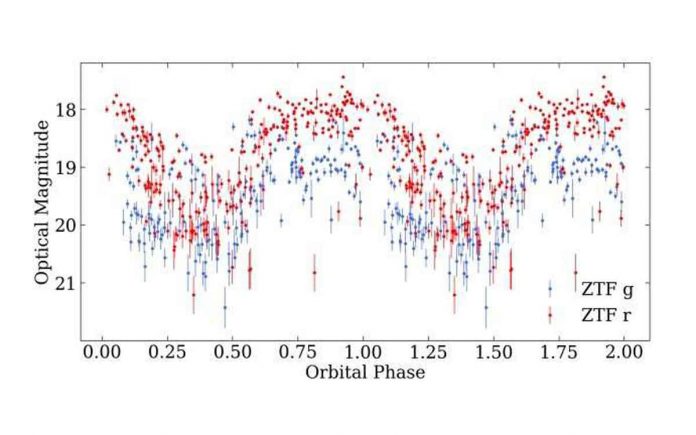Astronomers from the California Institute of Technology (Caltech) and other institutions discovered two new Polaris by analyzing data from the Spektr-RG (SRG) space observatory and the Zwicky Transient Facility (ZTF). The discovery is detailed in a paper published on the arXiv pre-print repository on June 9.
CVs are binary star systems that consist of a white dwarf and a normal star companion. They fluctuate in brightness by a large factor, then return to a quiescent state. Polaris are a type of cataclysmic variable distinguished from others by the presence of a powerful magnetic field in their white dwarfs.
A team of astronomers led by Caltech’s Antonio C. Rodriguez has discovered two new polars, designated ZTFJ0850+0443 and ZTFJ0926+0105. The detection was made by crossmatching the eROSITA Final Equatorial Depth Survey (eFEDS) catalog with ZTF Data Release 5 forced photometry (DR5).
“Through a crossmatch of the eFEDS dataset and ZTF archival photometry, we discovered two polars: ZTFJ0850+0443 and ZTFJ0926+0105,” the researchers wrote in their paper.
According to the research, ZTFJ0850+0443 is an eclipsing polar with an orbital period of 1.72 hours located 3,260 light-years from Earth. Its white dwarf has a mass of about 0.81 solar masses, and the companion star has a mass of about 0.12 solar masses. The results indicate that ZTFJ0850+0443 is most likely a low-field polar with a magnetic field strength of less than 10 MG.
ZTFJ0926+0105 is a non-eclipsing polar with an orbital period of about 1.48 hours at a distance of about 1,200 light-years. It has a more typical polar magnetic field strength—at least 26 MG. The team was unable to determine the mass of ZTFJ0926+0105 because it is not eclipsing.
The astronomers concluded that their discovery demonstrates the value of the eFEDS survey in supplementing ZTF for detecting new cataclysmic variables. Furthermore, they stated that using the ESA’s Gaia satellite, they will be able to obtain precise luminosities of the newly discovered polars. The recently released Gaia Data Release 3 (DR3), which was released on June 13, may be very useful in this context.
“Schwope et al. (2021) identified an eclipsing polar via an eROSITA/SRG crossmatch with Gaia using a proprietary eRASS dataset,” the researchers wrote. Rodriguez’s team’s research is part of a larger follow-up analysis of the eFEDS/ZTF footprint. Such studies could help overcome observational biases in previous optical-only searches for cataclysmic variables, leading directly to accurate volume-limited CV studies

